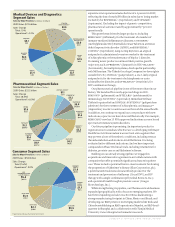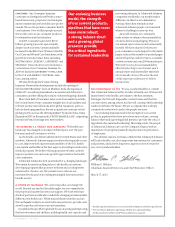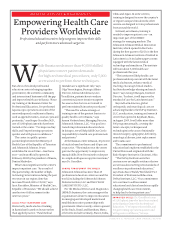Johnson and Johnson 2009 Annual Report Download - page 16
Download and view the complete annual report
Please find page 16 of the 2009 Johnson and Johnson annual report below. You can navigate through the pages in the report by either clicking on the pages listed below, or by using the keyword search tool below to find specific information within the annual report.
New product lines and new
markets for existing products
continue to provide growth
opportunities for the
consumer skin care portfolio.
In France,
™ is outpacing
some of its biggest competi-
tors thanks to its -year
heritage, natural ingredients
and good value-for-money
positioning. In ,
™
expanded to new markets,
including Belgium,
Switzerland, North Africa and,
most recently, Greece.
For more than years,
® has advanced the
science of natural products
in skin care and is a pioneer
in ®
ingredients. To that end, in
the brand launched the
®
™, an online
resource, in the U.S. and
Europe, with an aim to
increase knowledge about
natural ingredients in
skin care.
Also in , the brand
launched a new ®
+ Hair Care line
with its latest
® ingredient,
Nourishing Wheat Complex.
In August, ® Soothing
Bath Treatment became the
first body care product to earn
the new Green Good
Housekeeping Seal. And in
November, ® kicked
o a partnership with
TerraCycle to give new life to
empty ® product
“As a packaged goods
company we must proactively
manage waste—the waste that
results throughout our value
chain, including the waste our
consumers generate when
they use our products,” says
Paulette Frank, Vice
President, Sustainability
and Environmental Health
& Safety, Johnson & Johnson
Consumer Group of
Companies. “Refillable pack-
aging helps us oer a sustain-
able solution that meets the
needs of our consumers.”
Refills are gaining in
attractiveness to consumers,
particularly in the Asia Pacific
region. They now represent
more than percent of total
annual ® sales in
the Asia Pacific region and
percent of ®
Baby washes and shampoos
in that region.
In , ®
Self-Foaming
Wash ml refill in Japan was
upgraded to include a spout for
easier opening and pouring.
A refill pouch usually costs a
fraction of a comparably sized
bottle, helping to reduce
consumer costs as well as
environmental impact. A refill
uses less material for the
same volume sold, weighs less
and costs less to transport.
In developed markets,
johnson’s®
refills are often used to
promote high-volume value
deals to consumers, while
consumers in emerging
markets want smaller quanti-
ties
with less initial packaging.
“Refill or pouch packs are
also sold in very small sizes,
allowing mid-tier consumers
to buy them as the primary
pack and use quality brands
like ® at accessible
price points,” says Elkana
Ezekiel, ® Asia
Pacific Marketing Director,
Johnson & Johnson Consumer
Companies, Inc. “These
packs are driving growth in
emerging markets like China
and India.”
JOHNSON & JOHNSON 2009 ANNUAL REPORT14
























